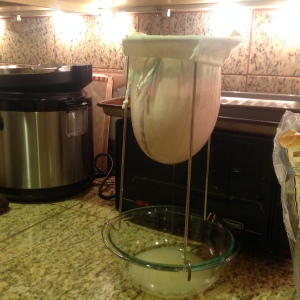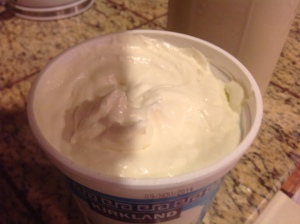Before we moved to the mountains of idaho I made yogurt, I made bread from freshly ground grains, I even made kombucha and kefir water, we’ve even tried our hand at brewing beer but honestly, none of it was second nature. First of all, I was definitely afraid of making a mistake and either wasting money on a science experiment gone terribly wrong or poisoning my family (no one wants their first batch of yogurt to send their family members to the emergency room). It all seemed a little mysterious and frankly, difficult. There were many times I would sit in wonder and awe thinking about homemakers in times past doing all of these things and wondering how it was possible. Well, I learned a valuable lesson the other day…you don’t have to over complicate the process, keeping it simple makes these things easy and doable.
I have gotten the chance to pick the brain of one of our homesteading neighbors (I use that word in the “country sense” since she lives a few miles away). She makes raw milk products including ricotta, mozarella, greek yogurt, butter, and sour cream, along with everything else she does on her farm. I was at her house the other day and she mentioned she was making yogurt. Like I said, I’ve made yogurt before but honestly it seemed like a very delicate process with exact temperatures, pristine environments, precise measurements, etc so I have always steered away from doing it on a regular basis. I was very curious to know how she did it since she seems to simplify everything. She’s lived on the mountain her entire life and has learned these things from family so I knew I was talking to an expert here.
The first thing I noticed was that she didn’t get all uptight about using equipment specifically created for yogurt making. She was using old flour sacks for draining the yogurt, a big stock pot for heating the milk, a wood stove to keep it warm, and plastic wrap and a towel to cover it. She was heating milk up, letting it cool to room temperature, stirring in a quart of her previously made yogurt and letting the pot rest next to her wood stove. It certainly wasn’t the “correct” way of making yogurt and I was surprised at how easy she made it look. One of my mottos has always been if you want to learn something or do something, just start! Don’t wait for the perfect situation or perfect equipment, just start. Seeing her uncomplicated set up motivated me to give it a go in a much looser way. Armed with the realization that everything I had thought necessary for making yogurt: quart-sized mason jars, double boiler, perfect temperature, thermometer (I used mine since it’s helpful but she doesn’t), and cheese cloth was not necessary I determined to start my first big batch when I got home. This is what I did and how it turned out.
Things I used:
- Large Pot
- Candy thermometer
- 1/3 cup plain yogurt with live cultures
- Saran wrap
- Towel
- Dehydrator (not necessary – even a crockpot would work)
- Fabric bag for straining
- Bowl
What I did:
- First, I put approximately 2/3 of a gallon of raw milk in a pot because that’s how much would fit in the big pot I have available right now, I put it on my stove at medium heat, covered it, and brought it up to 180 degrees (yes, I used a thermometer).
- I also set about 1/3 of a cup of plain yogurt that I got from my neighbor on the counter to let it warm to room temperature while I busied myself with other things. Once the milk reached 180 I took it off the stove and let it cool down to 110 (just warmer than body temperature).
- Next I needed to add the room temperature yogurt to the milk. I decided to thin it out first, so I took some of the warm milk and added it by tablespoon to the yogurt, stirring it with each addition, adding more milk little by little until it was a very thin consistency to make it easier to incorporate into the pot of milk.
- I then poured the yogurt/warm milk mixture into the pot and stirred it thoroughly. So I could use my big pot for dinner, I poured the milk into a large bowl (you can skip this step)
- I covered it in plastic wrap, wrapped it in a towel, then put it in my Excalibur dehydrator set to 110 degrees (we don’t have a wood stove so I couldn’t do it all her way and I would encourage you to get creative to figure out what you could do to keep the mixture at or around 110 degrees)
- I let it sit for about 18-24 hours (again, this was not an exact science).
- I started checking it for consistency the next day. She had shown me what she does…wash your hands first…uncover the bowl and push on the yogurt, if it bounces back it’s done. Basically, once it was custard-like I removed it from the dehydrator.
- The next step was draining the yogurt to thicken it up even more, so I spooned it in to jelly-straining bags letting it drain for a couple of hours. Next time I may drain it for only 15 min to make a thinner yogurt because It turned into a very thick greek yogurt (this could easily be used as sour cream it’s that thick). I made sure to reserve all the whey to use in recipes like making ricotta cheese and soaking grains.
This made one quart of yogurt so half of it turned into whey and half into a thick yogurt.
Depending on the cost of the milk you buy this may or may not be cost-effective for you. For us it’s worth it partly because it’s healthier, but primarily because I’m learning to do it and when we get our own milk cow we will have more milk than we can drink. The cost of making a quart of homemade greek yogurt for us right now is about $3.40 which is cheaper than I can get a quart of greek yogurt at the store and we enjoyed it more than any plain yogurt I’ve ever bought at the store or previously made. I may flavor some of the yogurt to add variety, but even the plain is very creamy and smooth with a sweet-tart flavor.
Basically, making yogurt is not a mystery, it’s not a science, it’s not a delicate process, it’s an art, and art has many forms, it’s forgiving in that we can each add our own personal touch and it still not be wrong. Follow the basic guidelines, be okay with making mistakes and experiment with it. My best advice – just start and don’t let mistakes stop you from trying again. Eventually you will succeed, and boy does that feel good!
I’m sorry about the sad lack of photos. I was so determined to start the project that by the time I realized I could share it with you I was almost done with the yogurt. I’ll take photos the next batch and post them here.
~Mon, The Permafarm Maiden






Leave a Reply
You must be logged in to post a comment.